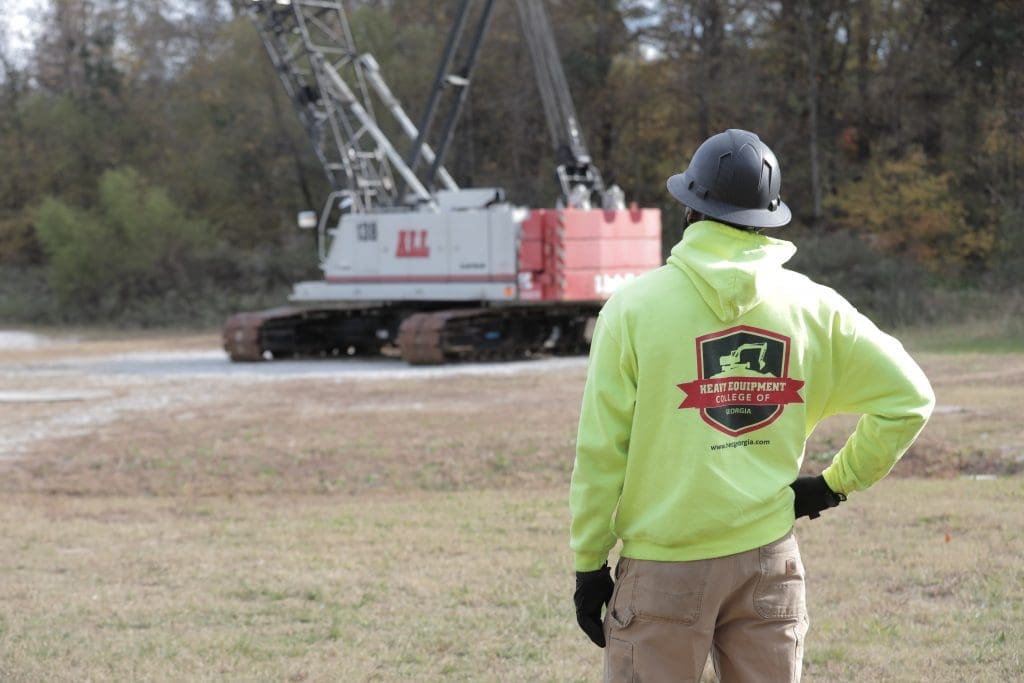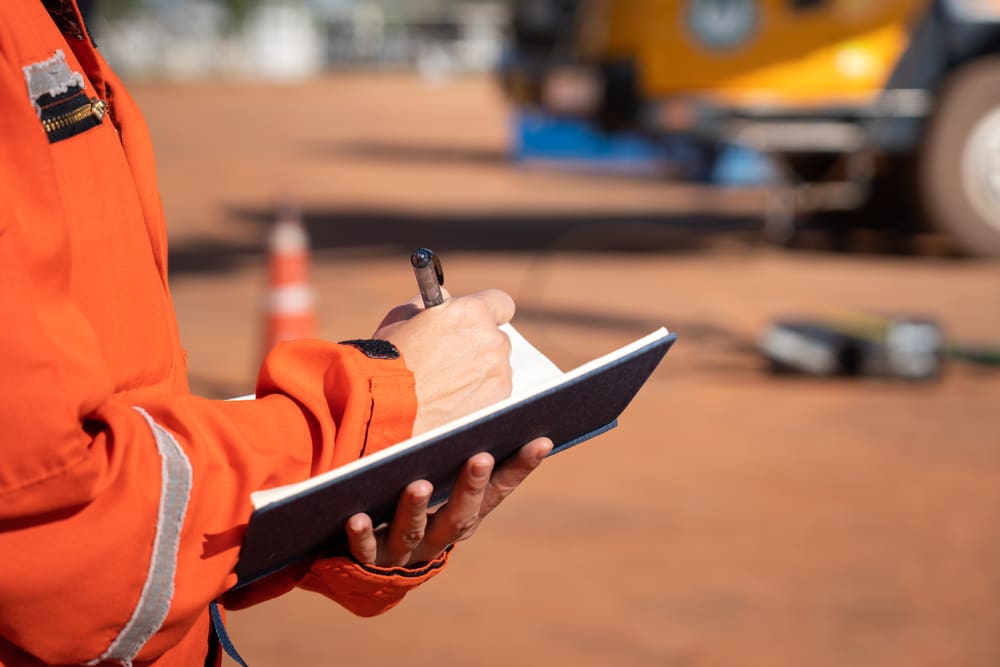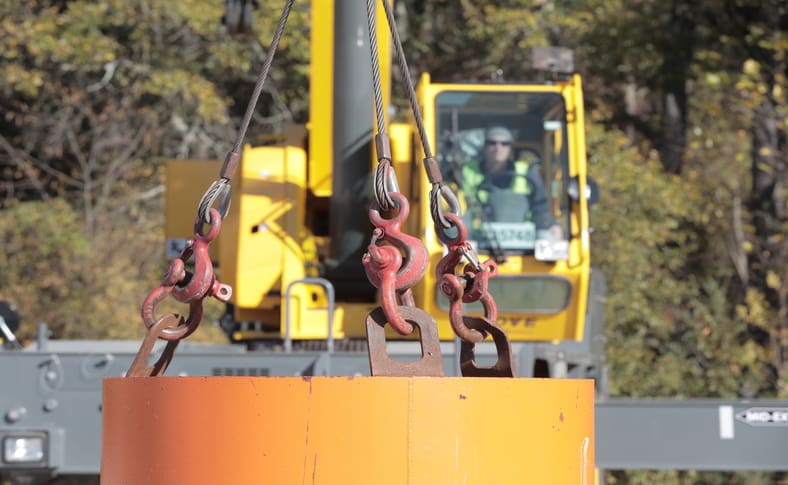A mobile crane is a crane controlled by a cable that is mounted on a crawler or rubber-tired carrier with a telescoping boom mounted on a truck-style carrier. These cranes are used in construction projects to move large and heavy materials that may be too difficult to move with other equipment. While a tower crane requires substantial foundation work and is immobile once built, mobile cranes are able to navigate tighter spaces and be transported easily to wherever they are needed on the site.
These mobile cranes play a crucial role in the productivity of construction sites, which is why it is important to make sure that these cranes are working properly and up to code. Performing routine inspections can help keep workers safe and catch any problems with the crane early on. This post will go over how mobile cranes work, discuss the importance of regular crane inspections for crane safety, and provide a mobile crane inspection guide.
How Does a Mobile Crane Work?
A mobile crane is typically mounted onto a truck or trailer so that it can be moved around easily and used in a variety of locations. Their parts and build can depend on the manufacturer, but overall they tend to consist of a chassis, boom, jib, and hook. The chassis refers to the base of the crane, including the truck or trailer that it is attached to. The boom is the long arm of the crane that can telescope to reach certain heights or navigate tight spaces, and it is used to lift heavy objects. The jib is a smaller arm on the crane that does not lift anything but rather stabilizes the load that the boom is carrying. Lastly, the hook is what attaches to the load and works with the boom to lift it.
Typically these cranes are controlled with a series of joysticks, levers, and pedals. Their mobility makes them more versatile on construction sites and more suited for construction projects with a shorter timeline.
The Importance of Mobile Crane Inspections
Routine mobile crane inspections not only create a record of the condition of the crane, but they also protect the safety of workers on construction sites with a crane as well as the crane operator. Inspections can catch potential issues early before they become more serious, and can even save costly repair expenses.
Who Should Inspect the Crane?
OSHA regulations require that a “competent person” must be the one to inspect a crane, with their definition of a competent person referring to an individual with extensive knowledge of crane operations, capacity limitations, as well as the OSHA standards for crane operations. While this can include a designated employee on the job site, hiring a third-party crane inspector may make sure that the inspection is thorough and unbiased, keeping workers safe and making sure that everything is up to OSHA standards.
Record Keeping and Documentation
Thorough documentation helps keep track of the operation of the crane as well as create a paper trail to reference in the future if necessary. These records should include the dates of any inspections, the name of the inspector who looked at the crane, and any findings or corrective actions that were taken to address an issue. These documents help protect not only workers but the company as a whole.

What Needs to be Documented?
Any and all documentation that pertains to mobile crane inspections should include the following information:
- The date the inspection took place
- The name and identification of the inspector who performed the inspection
- Any and all findings from the inspection
- Any and all corrective actions that were taken to address potential findings
Pre-Inspection and Collaboration
Before conducting a formal inspection of the mobile crane, an inspector will typically do the following.
- Review any past records of inspections to check for any past issues and learn the overall status of the crane.
- Review the manual for the crane to double-check the OSHA requirements and intended functions of the crane to reference back to during the inspection.
- Have an open conversation with the crane operator to understand the crane’s usage and any noticeable limitations with the crane and its functionality.
Record Retention Requirements
OSHA regulations require that the two most recent inspection records be kept for future reference, though holding onto all records indefinitely is not a bad practice. This helps create a clear history of the crane’s condition and function, and it can be used as evidence in the event something happens on a construction site.
How to Conduct a Crane Safety Inspection
The steps to perform a thorough crane safety inspection include the following.
- Conduct a Visual Inspection
- Walk around the crane and check for any noticeable damage or wear on the crane as a whole.
- Check that the hook is properly attached to the boom and that the boom is free of any damage and functioning properly.
- Inspect the Hydraulic System
- Check the hydraulics for any leaks, damage, or wear, and that all of the connections are secure and there are no clogs or contaminations in the lines.
- Inspect the Crane’s Controls
- Go into the cab of the crane and check for any damage or wear.
- Check that all controls are responsive and functioning properly.
- Check the Tires and Brakes
- Check that the tires are free of damage and the treads are clear.
- Ensure that the brake system is operational and that there is no damage to the brake line.
- Conduct Functional Tests
- Run tests to make sure that the crane’s movements are good to go, such as telescoping, swinging, and hoisting.

Mobile Crane Inspection Frequency
OSHA regulations say that mobile cranes should have an initial inspection along with frequent inspections and periodic inspections. Each of these inspections has different requirements and timelines for when they should be performed.
Initial Inspection
Initial Inspections are to be performed on any new cranes or cranes that have been recently altered before their initial use. These inspections should include:
- Reviewing all new or altered cranes before their first use,
- Replacing or repairing any damaged crane parts,
- Checking crane functions such as:
- Hoisting and Lowering
- Trolley Travel
- Bridge Travel
- Limit Switches
- Locking and Safety Devices, and
- Performing a load test.
Frequent Inspection
Frequent inspections should be performed daily or even monthly to check for any issues with the crane. These inspections should include:
- Performing a visual inspection to check for any damage to any part of the crane,
- Checking for any deterioration to any parts of the crane including the hook, hoist chains, and braking system, and
- Performing a monthly inspection with a certification.
Periodic Inspection
Periodic inspections should be performed every 1 to 12 months depending on how frequently the crane is used or the environment in which it is being used. These inspections should include:
- Checking for any worn or corroded parts of the crane
- Checking for any loose bolts or rivets
- Checking the fuel system
- Checking the electrical system
- Checking load, wind, and other indicators over their full range
Common Mobile Crane Inspection Mistakes
While routine inspections can improve the functionality of the mobile crane, minor slip-ups can lead to dangerous situations for workers. Common inspection mistakes stem from a lack of crane training, improper or incomplete inspections, or not keeping up with routine maintenance procedures.
Luckily, these issues can be managed or prevented with a strict maintenance schedule and thorough mobile crane operator training.
NCCCO Crane Recertification
There are many benefits to being NCCCO-certified, like increased job opportunities, high earning potential, improved workplace safety, and industry regulation compliance.
Start Enrollment ProcessBecome a Certified Mobile Crane Operator
Looking to become a certified mobile crane operator? The Heavy Equipment Colleges of America (HEC) has certification programs for numerous heavy equipment operators including mobile cranes.
Our heavy equipment programs thoroughly train students on how to operate and inspect heavy construction machinery in states across the United States, including California, Oklahoma, Washington, and Georgia. Contact us online or over the phone with any questions regarding the application process or the programs offered.

